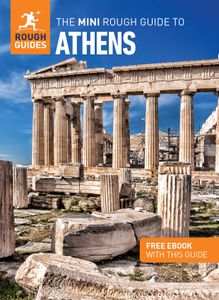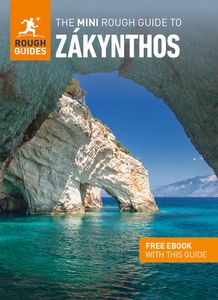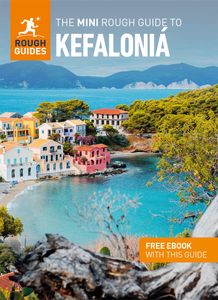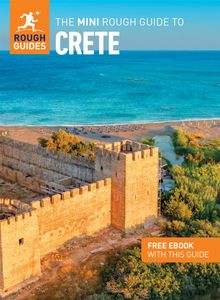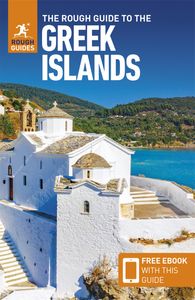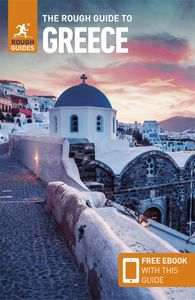Kórinthos
Like its ancient predecessor, KÓRINTHOS (modern Corinth) has been levelled on several occasions by earthquakes – most recently in 1981. Repaired and reconstructed, with buildings of prudent but characterless concrete, it is largely an industrial and agricultural centre, its economy bolstered by the drying and shipping of currants, for centuries one of Greece’s few successful exports (the word “currant” itself derives from “Corinth”). The modern city has little to offer the outsider, so plan on moving on quickly if you land up here.
The Corinth Canal
As you peer over from the bridge, the 6km Corinth Canal appears to be a very narrow strip of water, until a huge freighter from Pireás or cruise ship to the Ionian islands assumes suddenly toy-like dimensions as it passes nearly 80m below. Today, supertankers have tended to make it something of an anachronism but it is still used by large vessels and remains a memorable sight. At the northwestern end of the canal, by the old Kórinthos–Loutráki ferry dock, there are remains of the diolkos (summer Mon noon–7pm, Tues–Sun 8am–7pm; winter Tues–Sun 8.30am–3pm; free), a paved way along which a wheeled platform used to carry boats across the isthmus. In use from Roman times until the twelfth century, the boats were strapped onto the platform after being relieved temporarily of their cargo.
If you are travelling by car, the old national road passes directly over the canal, and it is fairly easy to park. Keep an eye out for a cluster of tourist shops and restaurants and you’ll know you’re there. Many buses also stop here.
Brief history
The idea for a canal providing a short cut and safe passage between the Aegean and Ionian seas harks back at least to Roman times, when Emperor Nero himself performed the initial excavations with his little silver shovel, later heavily supplemented by Jewish slave labour. It was only in the 1890s, however, that the technology finally became available for cutting right across the 6km isthmus. Opened in July 1893, the canal, along with its near-contemporary Suez, helped establish Pireás as a major Mediterranean port and shipping centre.
Ancient Corinth
The ruins of Ancient Corinth (Arhéa Kórinthos) occupy an extensive site 7km southwest of the modern city and are an essential stop. The site is split into a vast, impressively excavated city with the Temple of Apollo at its core, and even more compelling is the stunning acropolis site of Acrocorinth, towering 565m above the ancient city. To explore both you need a full day, or to stay overnight at the adjacent village.
Brief history
Ancient Corinth was a key centre of the Greek and Roman worlds, whose possession meant the control of trade between northern Greece and the Peloponnese. Not surprisingly, therefore, the area’s ancient and medieval history was one of invasions and power struggles that, in Classical times, was dominated by Corinth’s rivalry with Athens, against whom it sided with Sparta in the Peloponnesian War.
Having defeated the Greek city-states of the Achaean League, the Romans razed the city in 146 BC, before rebuilding it on a majestic scale in 44 BC under the command of Julius Caesar. Initially it was intended as a colony for veterans, later becoming the provincial capital. Once again Corinth grew rich on trade – with Rome to the west, and Syria and Egypt to the east. The city endured until rocked by two major earthquakes, in 375 and 521, which brought down the Roman buildings and again depopulated the site until a brief Byzantine revival in the eleventh century.
The excavations
Entering from the north, you are in the Roman agora, an enormous marketplace flanked by the substantial foundations of a huge stoa, once a structure of several storeys, with 33 shops on the ground floor. Opposite the stoa is a bema, a marble platform used for public announcements. At the far end are remains of a basilica, while the area behind the bema is strewn with the remnants of numerous Roman administrative buildings. Back across the agora, hidden in a swirl of broken marble and shattered architecture, there’s a fascinating trace of the Greek city – a grille-covered sacred spring, at the base of a narrow flight of steps.
More substantial is the elaborate Roman Fountain of Peirene, which stands below the level of the agora, to the side of a wide, excavated stretch of the marble-paved Lechaion Way – the main approach to the city. The fountain house was, like many of Athens’ Roman public buildings, the gift of the wealthy Athenian and friend of Emperor Hadrian, Herodes Atticus. Water still flows through the underground cisterns and supplies the modern village.
The real focus of the ancient site, though, is a rare survival from the Classical Greek era, the fifth-century BC Temple of Apollo, whose seven austere Doric columns stand slightly above the level of the forum, flanked by foundations of another marketplace and baths. Over to the west is the site museum (same hours as site; included in site admission), housing a large collection of domestic pieces, some good Greek and Roman mosaics from nearby, a frieze depicting some of the labours of Hercules, and a good number of Roman statues.
A number of miscellaneous smaller excavations surround the main site. To the west, just across the road from the enclosing wire, there are outlines of two theatres: a Roman odeion (endowed by Herodes Atticus) and a larger Greek theatre, used by the Romans for gladiatorial battles. To the north are the inaccessible but visible remains of an Asklepion (dedicated to the god of healing).
Acrocorinth
Rising almost sheer above the lower town and the fertile plains, the medieval fortress of Acrocorinth is sited on an imposing mass of rock, still largely encircled by 2km of wall. Despite the long, 4km climb (nearly an hour’s broiling walk) – or a ten-minute drive up from Ancient Corinth – a visit is unreservedly recommended. Looking down over the Saronic Gulf and the Gulf of Kórinthos, you get a real sense of its strategic importance. Amid the extensive remains is a jumble of chapels, mosques, houses and battlements, erected in turn by Greeks, Romans, Byzantines, Frankish crusaders, Venetians and Turks.
The Turkish remains are unusually substantial. Elsewhere in Greece evidence of the Ottoman occupation has been removed or defaced, but here, at the start of the climb to the entrance, you can see the still-used fountain of Hatzi Mustafa, Christianized by the addition of great carved crosses. The outer of the citadel’s triple gates is also largely Turkish; the middle is a combination of Venetian and Frankish; the inner, Byzantine, incorporating fourth-century BC towers. Within the citadel, the first summit (to the right) is enclosed by a Frankish keep – as striking as they come – which last saw action in 1828 during the War of Independence. Keeping along the track to the left, you pass some interesting (if perilous) cisterns, the remains of a Turkish bathhouse, and crumbling Byzantine chapels.
In the southeast corner of the citadel, hidden away in the lower ground, is the upper Peirene spring. This is not easy to find: look out for a narrow, overgrown entrance, from which a flight of iron stairs leads down some 5m to a metal screen. Here, broad stone steps descend into the dark depths, where a fourth-century BC arch stands guard over a pool of (nonpotable) water that has never been known to dry up. To the north of the fountain, on the second and higher summit, is the site of the Temple of Aphrodite; after its days as a brothel, it saw use as a church, mosque and belvedere.
Corinthian saints and sinners
Roman Corinth’s reputation for wealth, fuelled by its trading access to luxury goods, was soon equalled by its appetite for earthly pleasures – including sex. Corinthian women were renowned for their beauty and much sought after as hetairai (courtesans); over a thousand sacred prostitutes served a temple to Aphrodite/Venus, on the acropolis of Acrocorinth. St Paul stayed in Corinth for eighteen months in 51–52 AD, though his attempts to reform the citizens’ ways were met with rioting – tribulations recorded in his two letters to the Corinthians.







